Lost Vegas #1 ($3.50, Image)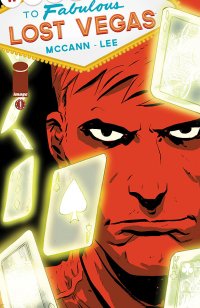
Sex #1 ($2.99, Image)
by D.S. Randlett (@dsrandlett)
All who read go through a certain phase, usually when one is a senior in high school or a college freshman. It’s when all of your leisure reading is composed of books by Hunter Thompson, William Burroughs, and Jack Kerouac. There is, of course, nothing wrong with that. All of these men are very good writers, and each of them have a lot to say. But the response to them is often a bit wrongheaded, based on a faulty assumption of what gives their work merit. While the extremes of their life experience doubtlessly colors the beat generation’s work, we often misread them as glorifying the sensual extremes that they have experienced (or at least, assuming that that is the whole point) instead of portraying them honestly along with the humanity and despair that occur alongside those extremes. The junk, sex, Wayfarers, and straw fedoras didn’t make the great writers of the beat generation great. What made them great was that they were willing to be honest about their own context and themselves.
As always, there have been rafts of cultural offshoots that have missed the point. For many, sensual extremes have become the very point of a certain school of media. It’s at the heart of the James Bond franchise, for example, which takes the shallow version of beat sensuality and spins it into what is equal parts male power fantasy and fashion porn. In many of these offshoots, the beats’ quests for Self takes a backseat, and we typically end up with narratives about… Stuff. Literally, stuff (fittingly, another euphemism for heroin). The original intent of the Beats gets turned toward the consumerist impulse, and the sensual extremes that the Beats inhabited get sanitized while it becomes assumed by lesser work that the answers to life’s questions lie within the Stuff. Fiction, as ever, becomes obsessed with the veneer of things.
There are two new comics from Image this week that belong very much to the post Beat milieu of sensual literature. The more typical of the two is Jim McCann and Janet Lee’s Lost Vegas. It fits into the Bond/Ocean mold of sensual literature, which ends up being a bit infuriating here. At least Ocean’s Eleven, the work that this book is most heavily drawing on, bothers to set up a core conflict behind Danny Ocean’s schemes. In Lost Vegas, the main character, Roland, is just a gambler who played a bad hand. Admittedly, the world that he inhabits is pretty cool, an interstellar version of Las Vegas (in case you couldn’t tell) that houses a diverse set of alien species, and has its own social structure wherein people indebted to the house end up as wage slaves. Roland gets captured by the house for incurring a steep tab, and the story revolves around him building a team that can help him get out. It’s made pretty obvious that Roland will eventually have to lead some sort of social upheaval, but the story isn’t there yet, and Roland even goes out of his way to tell the reader that he doesn’t care about the larger workings of Lost Vegas. The problem here is that the plot has no stakes for its principal character. I have no problem with him being a selfish cad, but his motivations don’t even feel driven by his caddishness or any sort of character trait at all. Rather, it feels as if the character is simply motivated by the needs of the plot to get Roland into a sharp outfit so he can fill the Bond/Ocean role. Granted, later issues may give Roland more concrete motivations and the plot may come together, but I’m not optimistic.
It’s a shame because Janet Lee’s art is quite good. Her art is a place where the story’s embrace of the sensual is an asset. Her figures are very cartoony, but not in the ways that that term usually conjures. The world she brings to life is basically a cross between Star Trek and a fashion sketch book, and she captures a feeling of voluptuousness that is typically absent from the brawny media of comic books.
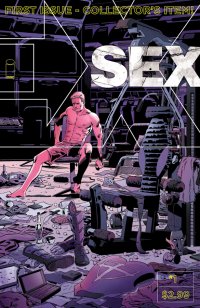 Joe Casey and Piotr Kowalski’s Sex fares a bit better. Rather than using the sensual to give its depthless story a veneer of “cool,” we have the portrayal of an ex-superhero returning to his home city for a fresh start. Simon Cooke is definitely cut from the Tony Stark mold. He is a business titan who once jetted around Saturn City as a hero called the Iron Saint. What’s interesting about this title is that it is unclear whether Cooke will suit up again, as the title of the series suggests that it will center around him looking for thrills in his post hero life. Still, there are rumblings in the underworld, with the leader of the city’s crime syndicates looking weak and younger criminals looking to take his place.
Joe Casey and Piotr Kowalski’s Sex fares a bit better. Rather than using the sensual to give its depthless story a veneer of “cool,” we have the portrayal of an ex-superhero returning to his home city for a fresh start. Simon Cooke is definitely cut from the Tony Stark mold. He is a business titan who once jetted around Saturn City as a hero called the Iron Saint. What’s interesting about this title is that it is unclear whether Cooke will suit up again, as the title of the series suggests that it will center around him looking for thrills in his post hero life. Still, there are rumblings in the underworld, with the leader of the city’s crime syndicates looking weak and younger criminals looking to take his place.
There is a lot happening in Sex, and it’s all very subtle, despite some very graphic sequences. Casey puts Simon Cooke front and center here, devoting most of this first issue’s length to a portrayal of just how lost he is. Leaving this first issue, you’re left with just enough mystery to see what happens in the plot, but also a compelling portrait of a man seeking to fill a void in himself and his separation from the things that he does in an attempt to fill that void. Here, sensuality becomes something not so much sinister indulgence as it is a means for Cooke to keep running away from something.
Kowalski’s art is very, very good. He effectively captures Cooke’s sense of disconnect, both in the book’s more mundane scenes and in its very graphic sex scenes. His characters feel a bit like those that Sean Philips draws, who manage to be rendered realistically, but have a sense of expressiveness usually unseen in more natural artistic styles. As a whole, Sex is easily one of the best new books that Image has put out in months.
Lost Vegas Rating: 




Out of a Possible 5 Stars
Sex Rating: 




Out of a Possible 5 Stars
Animal Man #18/Swamp Thing #18 (DC Comics, $2.99 ea)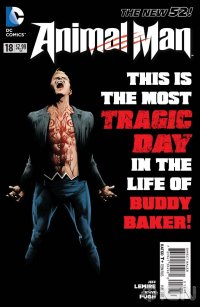
by Graig Kent
[Be warned: Spoilers]
Do you remember “Choose Your Own Adventure” books? They were hugely popular when I was a kid (a couple decades back now), but I’ve never seen one in the hands of my 11-year-old, or at the local library, so I’m wondering if they’re still a thing… and if not, when did they stop being a thing? Anyway, if you don’t know, the deal with “Choose Your Own Adventure” is each book is a stand-alone tale told with numerous paths the reader can choose to follow throughout. Usually each section of the story was a couple pages long with two options to choose from at the end, each taking you a different page in the book to resume the story until the next option comes up. As a reader, you could always step back and try the other way if you reach a dead end, like navigating a maze. I remember after reaching a conclusion I liked, I always went back and played with the structure to see what all the other possible paths were, and how many would lead to the same conclusion. My favourite thing to do was to see how few choices it would take to get to a stopping point. In some respects, a CYOA book was like a self-contained mini-multiverse, where the story follows a variety of pathways to a handful of inevitable endings.
I bring CYOA up is because it’s exactly what I was reminded of while reading through the latest issues of Animal Man and Swamp Thing, both concluding their parts in the Rotworld event that was woven into the fabric of the story each book was telling since their start in the New 52. The Rotworld mini-epic didn’t kick off proper until around the end of the first year of each title, but the books were obviously leading into it from the beginning, connecting the threads between animal (“the Red”) and vegetable (“the Green”), and the decay (“the Rot”) that threatens them both (together forming an intangible yet omnipresent trinity).
Over the past half year, Swamp Thing and Animal Man, each the avatar of their respective forces, have been fighting the avatar of the Rot, Anton Arcane. Rotworld kicked off when Alec Holland and Buddy Baker made a tragic decision to face off against Arcane in the ethereal realm where the Rot manifests, only to find they’ve succumbed to Arcane’s trap. When they emerged out the other end, they discovered that Arcane had triumphed and the Rot had taken over the majority of the world. A post-apocalyptic future, in the spirit of “Days of Future Past”, was laid out before the heroes, and they marched on a quest together and apart to both defeat their nemesis and learn the fate of their loved ones.
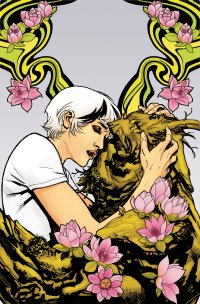 These books open where Swamp Thing ended last month, with the big undo button, flipping the pages back and choosing the other adventure. The Rot, collectively unsatisfied with the actions of their champion, alert Buddy and Alec to the fact that Arcane has figured out a way to step back in time through the timeless death and battle again and again until he reached the Rotworld conclusion he was looking for. The Rot offer up this passage to Buddy and Alec, in hopes that they can restore the balance that the trinity should truly retain.
These books open where Swamp Thing ended last month, with the big undo button, flipping the pages back and choosing the other adventure. The Rot, collectively unsatisfied with the actions of their champion, alert Buddy and Alec to the fact that Arcane has figured out a way to step back in time through the timeless death and battle again and again until he reached the Rotworld conclusion he was looking for. The Rot offer up this passage to Buddy and Alec, in hopes that they can restore the balance that the trinity should truly retain.
Though it was only for a couple issues throughout the whole Rotworld saga that Animal Man and Swamp Thing truly crossed over and interacted with each other, it’s kind of a disappointment to find them once again separated for the story’s conclusion. Moreover, where Buddy and Alec each wind up is more or left where they originally branched off, pretty much at the point where they decided to join forces rather than fight their individual battles. They went back upon the path they chose and picked the other adventure, with much different, and rather quickly resolved results.
The stark, attractive cover to this month’s Animal Man gives away that something bad happens. This something bad is quite relevant to the hot subject of comics today, namely kid deaths. This killing of kids, pre-teens or younger, is disturbing even if it’s not quite a trend yet. Are kids merely an extension of the adults who sired them, are they worth nothing more story-wise than how they impact their life, particularly in death? I look to Jonathan Hickman’s essential FF (Future Foundation) for how to handle kids in comics, making adventure stories that aren’t juvenile while equally not placing them in overly grim situations. Lian Harper, Damian Wayne, Cliff Baker. I know it’s coincidence, but I hope it doesn’t become a trend. I guess we’ll know if Franklin Richards winds up kicking it later this year.
That said, Animal Man has, from issue 1, been a book as much about Buddy Baker as it has his daughter, Maxine Baker, the heir apparent to the role of avatar of the Red. This issue really drives that point home, establishing just how much more powerful she is in comparison to her father, even at (an exceptionally mature) 4-years-old. Writer Jeff Lemire again asserts that the book and its title character’s focus is family. This may not be the most unique theme in the superhero genre, but the approach Lemire takes with it has always been much more emotionally grounded than even the foremost Fantastic family.
Over in Swamp Thing, a title I only started reading at the beginning of Rotworld, Alec returns to intercept Arcane’s murder of Abby. Abby it turns out also has ties to the Rot herself and, should she be able to weaken her Uncle, she could take on the role of avatar herself, something Arcane seems acutely aware of, and not too happy about.
I haven’t been a keen Swamp Thing reader, ever, but my assumption from what I have seen (and watched, given the… unique penetration into mainstream media) has always been that at its core, it’s a love story. The conclusion to Scott Snyder and Yanick Paquette’s run reaffirms that with some downright beautiful moments between Abigail and Alec, peaking with one of the most romantic death sequences ever.
While Snyder and Paquette nail the heart, the action is a lot less interesting. Paquette structures his pages in unique and creative manner, making for a visually stimulating layout, however the fight between Alec and Arcane is obtuse and kind of silly looking (particularly Paquette’s design for the beefed-up Arcane). This fight was inevitable and Snyder scripts it as such, as if it’s something he needs to get out of the way to get at the heart of the book.
Rotworld was a grand undertaking, exciting and suitably epic, so as a swansong swansong to the past year and a half of build-up in Animal Man and Swamp Thing, it’s mildly anti-climactic. However, as an ongoing chapter of the Animal Man series, this issue definitely adds new momentum. On the flip side, Swamp Thing seems a fitting finale to the story of Alec and Abby and a satisfying end to Snyder and Paquette’s run. It’s a definite conclusion, without closing the characters off completely for the new writer.
Animal Man Rating: 




Out of a Possible 5 Stars
Swamp Thing Rating: 




Out of a Possible 5 Stars
Age of Ultron #1 (Marvel, $3.99)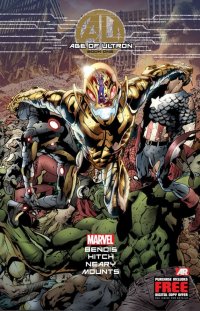
By Jeb D.
If your nostalgic sense has been awakened by Marvel’s plans to adapt the Days of Future Past storyline for the next X-Men film… and if you’ve been jonesing for more of the widescreen mayhem that Bryan Hitch brought to the glory days of The Ultimates… well, Hitchy, along with Brian Bendis, Paul Neary, and Paul Mounts, are here with precisely that mashup for your entertainment.
As regular Marvel readers probably know, this miniseries was pretty long-delayed (Hitch finished his pencils over a year ago), and having it pop up just as Marvel NOW! is refreshing the Marvel U feels a bit odd: despite the “present day” setting, we’re in some kind of alternate future, and those familiar with these comic book tropes could be forgiven for wondering at what point things branch off (for instance, did all this happen before the events of Superior Spider-Man? Are we seeing the post-Octavius Spidey? Or are we pretending that Otto’s still in there?).
But whatever: what we have here is a small group of renegade superheroes on the run from giant murdering robots (an army of Ultrons that have devastated humanity), set against the ruins of civilization—a sure formula for fun. This first extra-sized issue is focused on Hawkeye’s rescue of Spider-Man from the clutches of a passel of Marvel’s B-list baddies (The Owl, Hammerhead, etc.), who expect to be rewarded for turning Parker over to Ultron and the army of robots he created in his image and likeness, so to speak. Well, nothing works out quite the way anyone involved had anticipated, and when things get crazy, Hitch is back on familiar ground with Hawkeye’s Super-Special-Forces techniques: this is as visually entertaining as corporate superhero comics get.
Bendis’ script hits the expected beats for one of these stories of dystopian resistance. I was actually a bit surprised to see so many familiar faces; I sort of figured we’d have seen allusions to a few symbolic deaths that had already occurred, but apart from a reference to Thor being “gone,” we appear to have a generous complement of Avengers (New, Secret, and otherwise), including Iron Man, Cap, and Luke Cage, as well as Emma Frost leading a cadre of X-Men (including Wolverine). Tension is high, and Bendis keeps the snappy patter to a minimum (though both Clint and Peter get some good lines). The endpoint of this issue is also well-judged: it’s not precisely a cliffhanger; it suggests, on the other hand, that at least one key player has already gone over their own particular cliff, with unfortunate consequences for Our Heroes.
If this kind of corporate superhero storytelling still appeals to you, you should have a blast with this. Hitch, Mounts, and Neary have a few neat tricks to race your eyes through the panels, and slam you right into the thick of things.
Of course, it will be interesting to see how this one plays out structurally: a story that should have, essentially, capped off the pre-Marvel NOW! version of the Marvel U, is going to have to stand as a little self-contained island of awkward continuity alongside the new directions we’re seeing from writers like Remender, Fraction, Hickman, and Bendis himself. Just imagine if it works, though: it might actually convince the powers that be of the fact that endless reboots and resets aren’t needed to prolong the life of superhero comics: just get some great storytellers, with some good ideas, and turn them loose.
Rating: 




Out of a Possible 5 Stars